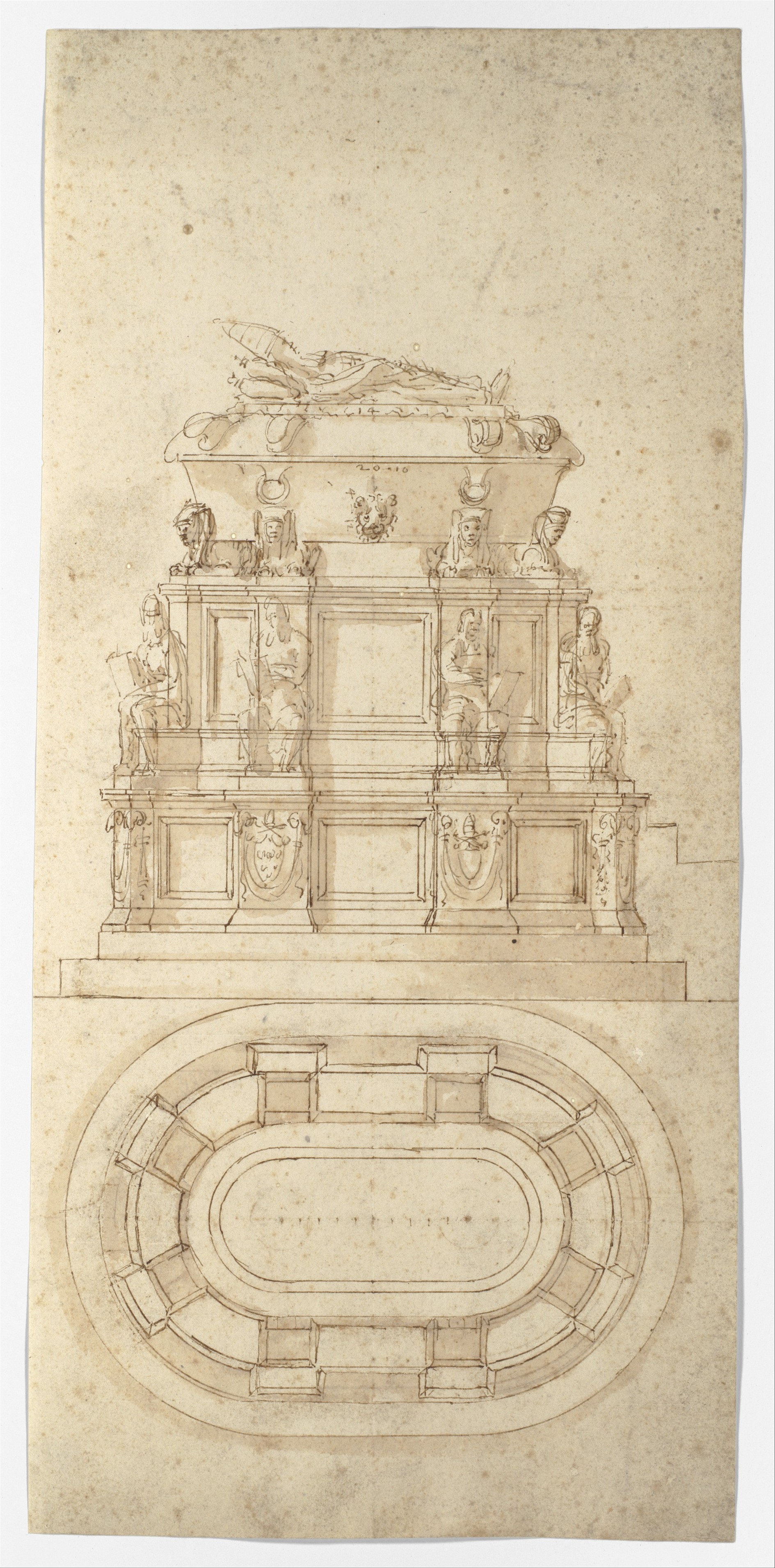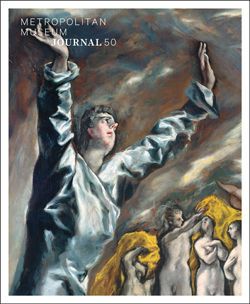Design for a Freestanding Tomb Seen in Elevation and Plan
Antonio da Sangallo, the Younger Italian
Not on view
This drawing was rediscovered and sold at auction in 1998, together with three other tomb designs, all four sheets dating to the 1530s; their attribution and subject matter were confirmed by Christoph Luitpold Frommel in the sale’s catalogue. The intended final projects with which the three other sheets were connected are less securely known than is true of the present sheet, which renders the intended project with great clarity of design and in a relatively finished conception.
The present drawing depicts the effigy of a bearded pope and on the lower part of the podium includes the papal tiara with crossed keys over the Medici family’s coat of arms -- the six balls, or palle -- which readily identifies the funerary monument as that of Clement VII de’ Medici (1478-1534), elected pope on November 19, 1523. This detailed modello, or demonstration drawing, may be compared to Michelangelo’s 'Tomb of Pope Julius II' as emanating from the same general tradition of clearly expository designs probably intended for the patron. Here, Sangallo rendered the freestanding tomb to be carved in marble in a consistent, precisely calibrated projection of the elevation with respect to the plan. This distinctive technique of drafting the dimensions of the plan and side views of a form in exact relationship to each other was still quite new in architectural drawings of the time. The Metropolitan Museum sheet by Sangallo is executed in pen and ink with wash over an extremely precise construction of direct stylus-incisions ("incisioni dirette"), done with compass and ruler, and with measurements carefully pricked with calipers; the grids of stylus-ruled lines coincide from plan to elevation above. While the overall condition of this working drawing is good, it exhibits small, scattered discolorations of the paper, slight soiling from handling, some minute worm holes, and foxing toward the upper border of sheet. The sarcophagus in the elevation (upper) part of the drawing was inscribed by the artist with several measurements; the cushion supporting the papal effigy apparently indicates "14" (probably 14 palmi, or 3.12 meters); while the upper rim of the sarcophagus notes "20-10" (probably 20 palmi, 10 once, or about 4.6 meters); and the lion’s head "4-12" (probably 4 palmi, 12 once, or about 1.17 meters). Both the bold, freehand manner of briefly sketching the figures and the precise, stylus-constructed drafting of the architectural elements in the Metropolitan Museum drawing are characteristic of the hand of Antonio da Sangallo the Younger.
The exact historical origins and context of Sangallo’s design, however, remain nebulous. One knows that as early as May 1524, Michelangelo had been requested by letter to produce designs for the marble double tombs of the Medici popes, Leo X (reigned, 1513-1523) and Clement VII, to be placed in the New Sacristy of S. Lorenzo (Florence), but that this idea of erecting the tombs there was abandoned soon after June 6, 1526 for lack of space. According to Giorgio Vasari, on his return from Rome, Pope Clement awarded Baccio Bandinelli the commission for the papal tombs to be erected at Santa Maria sopra Minerva. In any case, the project for the double papal tombs again received serious attention only after Clement’s death on September 23, 1534, when a variety of sculptors and architects seem to have competed to obtain the commission to design the sumptuous marble tombs. The contract for the overall design was awarded by the executors of Clement’s will (Cardinals Giovanni Cibo, Giovanni Salviati, and Niccolò Ridolfi) to Baccio Bandinelli in March 1536. It was to be the most prestigious sculptural commission of early sixteenth-century Rome after Michelangelo’s Julius Tomb. Two extant large drawings by Bandinelli detail his ideas for the double tombs of the Medici popes at a relatively advanced stage (Academia de San Fernando, Tomo II.14, Madrid; and Ashmolean Museum P II 48, Oxford). The tombs were completed in 1541, and were finally installed facing each other in the choir of Santa Maria sopra Minerva.
In all likelihood, the present drawing offers an early idea by Antonio da Sangallo for the tomb of Clement VII, around 1534-36, when the notion was still to produce separate tombs for the Medici popes, and this first project by Sangallo seems to have evolved from solutions previously explored by him in designs for a funerary monument to Piero de’ Medici at Montecassino, ca. 1531. As was the case at Montecassino, Sangallo’s ideas for the funerary project at Santa Maria sopra Minerva may have arisen from his involvement in the extensive architectural remodeling of the church’s choir. Sangallo’s main role at the site in Santa Maria sopra Minerva was as architect, not scultptor. In conception, the Metropolitan Museum sheet is totally unlike the highly developed later solution for a three-bay wall tomb of Clement VII, as drawn to scale in "palmi romani" on a sheet now at the Graphische Sammlung Albertina inv. 15461, Vienna (Fig. 1), which may be attributed to the Sangallo workshop, but which exhibits notes by the Bandinelli family. The Albertina sheet by the Sangallo wokshop (a presentation drawing for the executors of Pope Clement’s will) portrays the animated statue of the pope blessing from his throne within the design of a triumphal arch, in a solution closer to Baccio Bandinelli’s ideas of the late 1530s. In contrast to the later Albertina design by the Sangallo workshop, the effigy of the dead pope in the Metropolitan Museum drawing rests flatly on a tall sarcophagus, which is supported by Egyptian-style sphinxes, while statues of seated male holy figures (very likely prophets and evangelists), holding books or tablets, accent the engaged pilasters of the tall base in a rhythm of decoration that strongly evokes Michelangelo’s Tomb of Pope Julius II, both in the preliminary drawings and in the final design of the monument as erected in 1545 at San Pietro in Vincoli, Rome.
Until the discovery in 1998 of this drawing now at the Metropolitan Museum of Art, the design by Antonio da Sangallo the Younger for the Medici papal tomb had been known from a number of autograph summary sketches in pen and brown ink (Uffizi inv. nos. 185 A, 1129 A, 1559 A, Florence), as well as from a "disegno-ricordo" -- or exact studio "clean copy" though without wash, or stylus construction -- attributed to Antonio’s brother, Giovanni Battista da Sangallo "Il Gobbo" (Uffizi inv. 183 A), born in 1496, hence junior by three years, and who is documented as his assistant from 1521 onward; "Il Gobbo" frequently performed as the surveyor, estimator, and amanuensis of his brother even as he was an accomplished draftsman in his own right. Antonio da Sangallo the Younger’s Tomb of Clement VII drawing occupies a significant place in the history of Renaissance tomb design, as funerary monuments conceived of in the round were still relatively rare by the 1530s, although ambitious precedents existed in the bronze Tomb of Pope Sixtus IV by Antonio del Pollaiuolo (Sacristy Museum, Basilica of Saint Peter’s), signed and dated 1493, and in the preliminary drawings by Michelangelo for the Tomb of Pope Julius II (see cat. no. 000), as explored in the early project of ca. 1505-6, and in the mature projects dating after 1513. In this history, the tomb of 1574 for Pope Paul III at Saint Peter’s Basilica ranks among the first built freestanding funerary design of the sixteenth century. Sangallo’s tomb design with its elegantly unified massing and tidy oval plan may have constituted a pointed reaction to Michelangelo’s reworking of the Julius Tomb after 1513 as a gigantic mausoleum of innumerable figures, and it is worthy of some note, in this respect, that Sangallo’s and Michelangelo’s personal differences over aesthetic vocabulary caused them to become hated rivals in the field of architecture during the late 1530s, and 1540s, in particular regarding the design of Saint Peter’s Basilica.
(Carmen C. Bambach, 2009, revised in 2014)
Due to rights restrictions, this image cannot be enlarged, viewed at full screen, or downloaded.
This artwork is meant to be viewed from right to left. Scroll left to view more.





